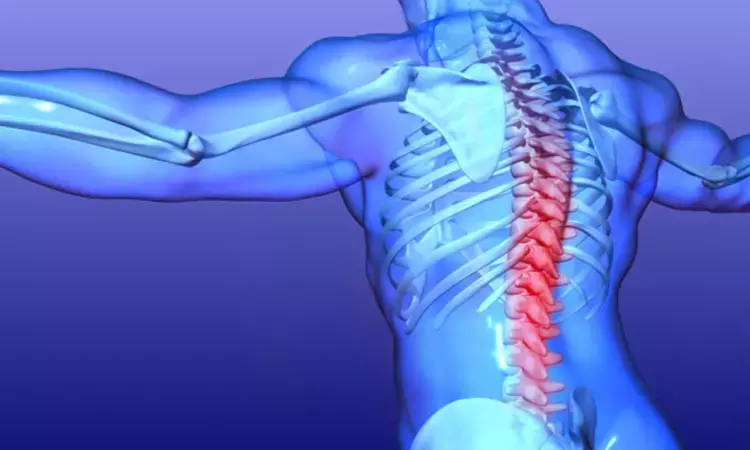- Home
- Medical news & Guidelines
- Anesthesiology
- Cardiology and CTVS
- Critical Care
- Dentistry
- Dermatology
- Diabetes and Endocrinology
- ENT
- Gastroenterology
- Medicine
- Nephrology
- Neurology
- Obstretics-Gynaecology
- Oncology
- Ophthalmology
- Orthopaedics
- Pediatrics-Neonatology
- Psychiatry
- Pulmonology
- Radiology
- Surgery
- Urology
- Laboratory Medicine
- Diet
- Nursing
- Paramedical
- Physiotherapy
- Health news
- Fact Check
- Bone Health Fact Check
- Brain Health Fact Check
- Cancer Related Fact Check
- Child Care Fact Check
- Dental and oral health fact check
- Diabetes and metabolic health fact check
- Diet and Nutrition Fact Check
- Eye and ENT Care Fact Check
- Fitness fact check
- Gut health fact check
- Heart health fact check
- Kidney health fact check
- Medical education fact check
- Men's health fact check
- Respiratory fact check
- Skin and hair care fact check
- Vaccine and Immunization fact check
- Women's health fact check
- AYUSH
- State News
- Andaman and Nicobar Islands
- Andhra Pradesh
- Arunachal Pradesh
- Assam
- Bihar
- Chandigarh
- Chattisgarh
- Dadra and Nagar Haveli
- Daman and Diu
- Delhi
- Goa
- Gujarat
- Haryana
- Himachal Pradesh
- Jammu & Kashmir
- Jharkhand
- Karnataka
- Kerala
- Ladakh
- Lakshadweep
- Madhya Pradesh
- Maharashtra
- Manipur
- Meghalaya
- Mizoram
- Nagaland
- Odisha
- Puducherry
- Punjab
- Rajasthan
- Sikkim
- Tamil Nadu
- Telangana
- Tripura
- Uttar Pradesh
- Uttrakhand
- West Bengal
- Medical Education
- Industry
Rare case of tophaceous spinal gout leading to acute spinal cord compression in young man

UK: A recent case study published in BMJ Case Reports describes a rare manifestation of tophaceous spinal gout resulting in acute spinal cord compression in a young man with a history of chronic gout.
"This case demonstrates that spinal gout is an important differential to be considered in chronic gout patients, presenting with acute back pain," Francois Okoroafor, Neurosurgery Department, Sheffield Teaching Hospitals NHS Foundation Trust, Sheffield, UK, and colleagues wrote in their case report.
A gout is a prevalent form of inflammatory arthritis caused by the deposition of monosodium urate (MSU) crystals in the joints. It typically affects peripheral joints, but axial involvement, such as spinal gout, is uncommon. Spinal gout is rare and challenging to diagnose and treat. Gout risk factors include diuretic use, chronic kidney disease, and reduced uric acid clearance.
Tophaceous spinal gout is characterized by MSU crystal deposition in the axial skeleton and is rare but can cause spinal cord compression. Diagnosis is challenging due to radiological and clinical overlap with other conditions. Differential diagnoses include metastatic disease, infective discitis, chronic back pain, cauda equina syndrome, and epidural abscess.
Dual-energy CT can aid diagnosis by MSU crystal identification. Management often involves combined medical and surgical approaches.
The case concerns a man in his 30s with a history of chronic gout presented with flaccid paralysis of the lower limbs, acute thoracic back pain, and urinary retention. He had a 10-year history of asthma, obesity, and gout. He had experienced polyarticular flare-ups managed with nonsteroidal anti-inflammatory analgesics and colchicine. There was a recent increase in the frequency of his gout flare-ups despite starting allopurinol.
Initial investigations showed increased C-reactive protein levels. CT of the thoracolumbar spine revealed abnormal facet joints at T8/9 with evidence of erosion, raising suspicion of septic arthritis. The identification of spinal cord signal changes at T8/T9, a high T2 signal surrounding the cord at T8-T10 and an epidural collection at T8/T9 was done by further MRI using a wide-bore scanner.
Okoroafor and the team performed emergency posterior thoracic decompression and evacuation of the epidural collection. Further examination was done for a “cheese-like” material removed during surgery. Laboratory results did not show conclusive evidence of infection, despite this, patients received antimicrobial treatment.
Histopathology examination showed amorphous material surrounded by chronic inflammation, indicating tophaceous spinal gout. The patient was treated with colchicine, steroids, and increased allopurinol.
Following treatment initiation, there was an improvement in the patient's inflammatory markers, and he was transferred to a neurorehabilitation unit for spinal injury rehabilitation. The patient remained paraplegic with limited mobility despite improved gout symptoms and inflammatory markers.
"Tophaceous spinal gout is an uncommon, but possible, cause of acute spinal cord compression, particularly in patients with chronic gout," the team concluded. "Early surgical intervention may aid in diagnosis and prevent further neurological deterioration."
Reference:
Okoroafor F, Ghazali S, Bhattacharyya DTophaceous spinal gout in a young man with complete spinal cord injury. BMJ Case Reports CP 2023;16:e256360.
Dr Kamal Kant Kohli-MBBS, DTCD- a chest specialist with more than 30 years of practice and a flair for writing clinical articles, Dr Kamal Kant Kohli joined Medical Dialogues as a Chief Editor of Medical News. Besides writing articles, as an editor, he proofreads and verifies all the medical content published on Medical Dialogues including those coming from journals, studies,medical conferences,guidelines etc. Email: drkohli@medicaldialogues.in. Contact no. 011-43720751


